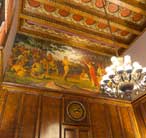The Conclave of Pontiac and Rogers’ Rangers at the Cuyahoga River, November 1760
Painting, Court of Appeals Court Room, West Wall
 The painting depicts the meeting of Rogers Rangers with Pontiac, a French ally and Chief of the Ottawas. Robert Rogers and his Rangers had traveled west at the end of the French and Indian War to take possession of the outposts. Pontiac initially ordered the Rangers to leave the country as he claimed that the land belonged to the Native Americans. Rogers, however, explained his mission to Chief Pontiac, and announced that the French and Indian War had ended and peace was declared. Apparently convinced, Pontiac and other Native American leaders eventually agreed to smoke the peace pipe.
The painting depicts the meeting of Rogers Rangers with Pontiac, a French ally and Chief of the Ottawas. Robert Rogers and his Rangers had traveled west at the end of the French and Indian War to take possession of the outposts. Pontiac initially ordered the Rangers to leave the country as he claimed that the land belonged to the Native Americans. Rogers, however, explained his mission to Chief Pontiac, and announced that the French and Indian War had ended and peace was declared. Apparently convinced, Pontiac and other Native American leaders eventually agreed to smoke the peace pipe.  One commentator attested to the painting’s accuracy (also alluding to the other painting in the Appeals Court Room-see the Trial of Captain John Smith), noting that everything, “such as canoes, battle-axes, flint rifles and spears were drawn from the originals,” those being supplied by the Museum of Ethnology headed by Dr. William H. Hunt. It was also noted that the figures were drawn from live models wearing the apparel appropriate to the times represented; and that those models had rehearsed their parts to become familiar with the “natural poses, mannerisms and facial peculiarities” of the characters portrayed.
One commentator attested to the painting’s accuracy (also alluding to the other painting in the Appeals Court Room-see the Trial of Captain John Smith), noting that everything, “such as canoes, battle-axes, flint rifles and spears were drawn from the originals,” those being supplied by the Museum of Ethnology headed by Dr. William H. Hunt. It was also noted that the figures were drawn from live models wearing the apparel appropriate to the times represented; and that those models had rehearsed their parts to become familiar with the “natural poses, mannerisms and facial peculiarities” of the characters portrayed.  The artist, Charles Yardley Turner, was born in Baltimore Maryland in 1850, studying art in Europe under various French masters. Turner served as the assistant director of decoration at the 1893 World’s Columbian Exhibition held in Chicago, and was the colorist for the entire 1901 Pan American Exposition in Buffalo, New York. In addition to his two paintings (also see “The Trial of Captain John Smith at Jamestown, June 10, 1607, East Wall, Court of Appeals Court Room) at the Cuyahoga County Court House Turner also painted murals for the Essex County Court House in Newark, New Jersey, the Hudson County Courthouse, in Jersey City, New Jersey, and the Baltimore Court House.
The artist, Charles Yardley Turner, was born in Baltimore Maryland in 1850, studying art in Europe under various French masters. Turner served as the assistant director of decoration at the 1893 World’s Columbian Exhibition held in Chicago, and was the colorist for the entire 1901 Pan American Exposition in Buffalo, New York. In addition to his two paintings (also see “The Trial of Captain John Smith at Jamestown, June 10, 1607, East Wall, Court of Appeals Court Room) at the Cuyahoga County Court House Turner also painted murals for the Essex County Court House in Newark, New Jersey, the Hudson County Courthouse, in Jersey City, New Jersey, and the Baltimore Court House.How could we make it better?
Please leave a comment before submitting.
Thank you for your feedback
Your feedback means a lot to us. We use it to improve the experience of all of our users.
 An official website of the Cuyahoga County government. Here’s how you know
An official website of the Cuyahoga County government. Here’s how you know


